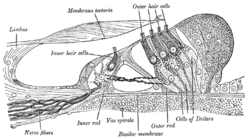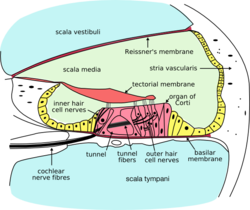Hair cell
| Hair cell | |
|---|---|

Section through the spiral organ of Corti. Magnified. ("Outer hair cells" labeled near top; "inner hair cells" labeled near center).
|
|

Cross-section of the cochlea. The inner hair cells are located at the termination of the "inner hair cell nerves" and the outer hair cells are located at the termination of the "outer hair cell nerves".
|
|
| Details | |
| Location | Cochlea |
| Morphology | Unique (see text) |
| Function | Amplify sound waves and transduce auditory information to the Brain Stem |
| Neurotransmitter | Glutamate |
| Presynaptic connections | None |
| Postsynaptic connections | Via auditory nerve to vestibulocochlear nerve to inferior colliculus |
| Identifiers | |
| NeuroLex ID | nifext_61 |
|
Anatomical terminology
[]
|
|
Hair cells are the sensory receptors of both the auditory system and the vestibular system in the ears of all vertebrates. Through mechanotransduction, hair cells detect movement in their environment. In mammals, the auditory hair cells are located within the spiral organ of Corti on the thin basilar membrane in the cochlea of the inner ear. They derive their name from the tufts of stereocilia called hair bundles that protrude from the apical surface of the cell into the fluid-filled cochlear duct. Mammalian cochlear hair cells are of two anatomically and functionally distinct types, known as outer, and inner hair cells. Damage to these hair cells results in decreased hearing sensitivity, and because the inner ear hair cells cannot regenerate, this damage is permanent. However, other organisms, such as the frequently studied zebrafish, and birds have hair cells that can regenerate. The human cochlea contains on the order of 3,500 inner hair cells and 12,000 outer hair cells at birth.
Outer hair cells mechanically amplify low-level sound that enters the cochlea. The amplification may be powered by the movement of their hair bundles, or by an electrically driven motility of their cell bodies. This so-called somatic electromotility amplifies sound in all land vertebrates. It is affected by the closing mechanism of the mechanical sensory ion channels at the tips of the hair bundles.
The inner hair cells transform the sound vibrations in the fluids of the cochlea into electrical signals that are then relayed via the auditory nerve to the auditory brainstem and to the auditory cortex.
...
Wikipedia
